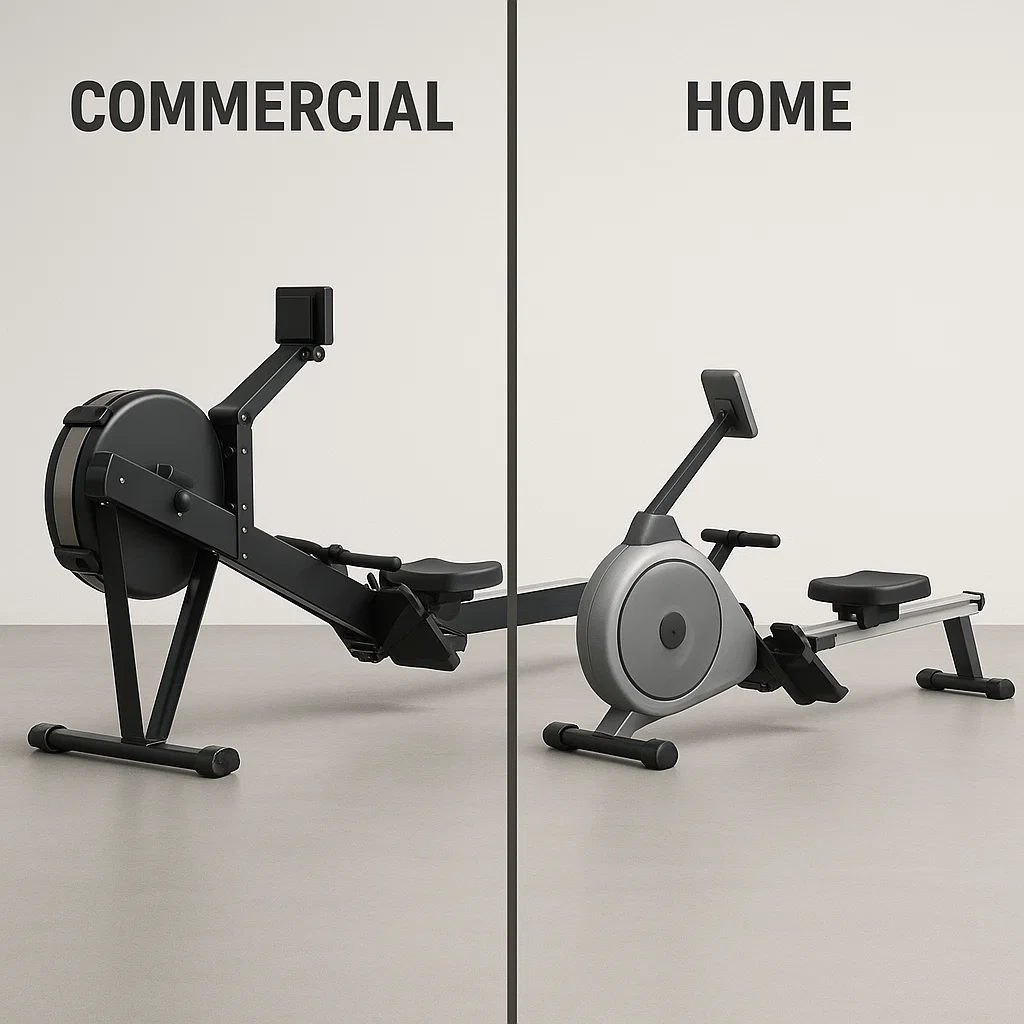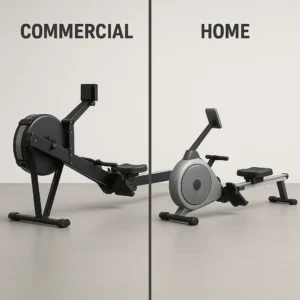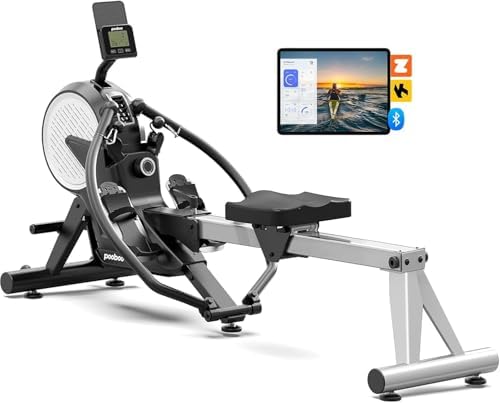
Table of Contents
Commercial vs. Home Rowing Machines: Key Differences You Need to Know
Rowing machines have taken the fitness world by storm, and for good reason. They provide a low-impact, full-body workout that engages over 85% of your muscles, strengthens your cardiovascular system, and torches calories without straining your joints. Whether you’re a professional athlete, a casual fitness enthusiast, or just someone who wants to improve their health from the comfort of home, a rowing machine can be a game-changer.
But here’s the catch—not all rowing machines are created equal.
If you’ve ever shopped for one, you’ve likely noticed two categories dominating the market: commercial rowing machines (the kind you see in gyms) and home rowing machines (designed for personal use). While both types serve the same fundamental purpose—mimicking the rowing motion to give you an effective workout—their design, durability, features, and price vary significantly.
This guide will break down everything you need to know about commercial vs home rowing machines so you can confidently choose the right one.
1. Understanding the Purpose: Why the Distinction Exists
Before diving into the differences, it’s important to understand why we even have two categories—commercial and home rowing machines.
-
Commercial Rowing Machines:
These are built for high-volume usage. Think gyms, fitness studios, rehabilitation centers, or professional training facilities. They’re designed to withstand dozens, sometimes hundreds, of users daily. Their engineering focuses on durability, reliability, and performance consistency.
-
Home Rowing Machines:
These are designed with the individual user in mind. They prioritize space-saving features, affordability, and convenience. While they’re still effective for workouts, they’re not expected to endure the same heavy-duty usage as gym-grade machines.
👉 The main reason this distinction exists is because the needs of a gym vs. an individual are vastly different. A gym owner wants something that won’t break down after continuous use, while a home user likely values affordability and compact storage more than industrial strength.
Imagine it this way: buying a commercial rowing machine for personal use is like purchasing a professional-grade restaurant oven just to bake cookies at home. It’s powerful, yes—but probably more than you really need.
2. Build Quality and Durability
When comparing commercial vs home rowing machines, build quality is one of the most striking differences.
Commercial Rowing Machines
-
Materials: Built from high-grade steel, reinforced aluminum, and industrial plastics designed to withstand years of abuse.
-
Weight Capacity: Often support users up to 500 lbs or more, making them inclusive for all body types.
-
Longevity: These machines can last 10+ years with proper maintenance, even in busy gyms.
-
Wear-Resistant Components: Commercial machines often feature reinforced chains, premium bearings, and heavy-duty seats/slides that don’t wear down quickly.
Home Rowing Machines
-
Materials: Many are made from lightweight steel or aluminum, with some budget models relying heavily on plastic components. Premium ones, like water rowers, are often crafted from wood, adding a stylish touch for home environments.
-
Weight Capacity: Usually ranges from 250–350 lbs, sufficient for most users but not as robust as commercial machines.
-
Longevity: With regular home use (say 30–60 minutes a day), a good-quality home rower can last 5–7 years.
-
Wear Resistance: Components may wear faster under heavy use, especially in budget models with plastic tracks or low-quality chains.
👉 Verdict: If you want something that can survive daily, intense workouts for years, go commercial. If you just want a reliable machine for a few sessions per week at home, a home rower should do the job.

3. Resistance Types and Performance
The resistance mechanism defines how smooth, quiet, and realistic your rowing experience feels.
Commercial Rowing Machines
-
Air Resistance: Popular in high-end gym rowers (e.g., Concept2). Provides variable resistance—the harder you row, the more resistance you feel. Feels close to real rowing.
-
Water Resistance: Found in premium machines like WaterRower. Uses actual water in a tank for the most natural rowing stroke possible. Common in boutique fitness studios.
-
Hybrid Systems (Air + Magnetic): Some advanced commercial rowers combine the smoothness of air with the adjustability of magnets, offering precise resistance control.
Home Rowing Machines
-
Magnetic Resistance: Most common in budget and mid-range home rowers. It’s quiet and smooth, making it ideal for apartments. However, it doesn’t replicate the real rowing feel as well as water or air.
-
Hydraulic Pistons: Found in very cheap models. Compact, but not very durable or realistic.
-
Air & Water Resistance: Available in higher-end home models, but at a cost closer to commercial machines.
👉 Verdict: Commercial machines excel in performance realism (air/water), while home machines often focus on quiet operation and convenience (magnetic).
4. Size, Storage, and Space Requirements
A key consideration for buyers is where you’ll put the machine.
Commercial Rowing Machines
-
Size: Large and heavy, often 7–9 feet long and weighing over 80–120 lbs.
-
Storage: Rarely foldable, as they’re built for permanent gym floors.
-
Mobility: Not easy to move around, though some models have wheels for repositioning.
Home Rowing Machines
-
Size: More compact, with many models designed to fit smaller rooms.
-
Foldability: Many home rowers fold upright or in half, reducing their footprint by up to 60% when not in use.
-
Mobility: Lightweight and portable, often with built-in transport wheels.
👉 Verdict: For home users, compact and foldable designs make storage a breeze. For gyms, size isn’t an issue, and sturdiness matters more than portability.
5. Technology and Features
In today’s fitness world, technology is a huge selling point.
Commercial Rowing Machines
-
Performance Monitors: Advanced displays showing stroke rate, distance, split time, heart rate, watts, and more.
-
Workout Programs: Preloaded training sessions, HIIT intervals, and performance tracking.
-
Connectivity: Bluetooth, ANT+, and app integrations with platforms like Zwift, Kinomap, and ErgData.
-
Interactive Features: Some models include HD touchscreens with virtual rowing experiences, on-demand classes, or live leaderboards.
Home Rowing Machines
-
Basic Monitors: Many budget machines only display time, distance, and calories.
-
App Support: Mid-range and premium home models may include Bluetooth connectivity for apps like iFit, MyRow, or Hydrow.
-
Entertainment Options: High-end smart rowers (like Hydrow or NordicTrack) provide immersive guided workouts, but these often require subscriptions.
👉 Verdict: Commercial machines win in raw performance data and reliability, while modern home machines focus on immersive training experiences to keep motivation high
6. Price and Overall Value
When comparing commercial vs home rowing machines, the price difference is often the first thing buyers notice.
Commercial Rowing Machines
-
Price Range: Typically start around $1,000 for entry-level commercial models and can reach $3,000–$4,000+ for premium machines with advanced features.
-
What You’re Paying For: Superior build quality, advanced resistance systems, detailed performance monitoring, and long-lasting durability.
-
Value for Money: Ideal for gyms, training centers, or athletes who will use the machine daily and push it to its limits.
Home Rowing Machines
-
Price Range: Entry-level models start as low as $200–$300. Mid-range options fall between $500–$1,000, while premium smart rowers may cost $1,500–$2,500.
-
What You’re Paying For: Affordability, convenience, and user-friendly features tailored to personal fitness.
-
Value for Money: Perfect for individuals or families who want a reliable workout without overspending.
👉 Verdict: If budget is your main concern, home machines are the clear winner. But if you consider rowing as a long-term investment or run a facility, commercial models offer unmatched value.
7. Maintenance and Lifespan
A rowing machine is not a one-time purchase—you also need to consider maintenance and durability.
Commercial Rowing Machines
-
Maintenance Needs: Require periodic inspections, lubrication of chains or rails, and occasional replacement of worn parts.
-
Service Life: Can last over a decade in a high-use gym setting, provided they’re well-maintained.
-
Manufacturer Support: Commercial machines often come with extended warranties and professional servicing options.
Home Rowing Machines
-
Maintenance Needs: Generally lower, especially magnetic resistance models (fewer moving parts = less upkeep).
-
Service Life: Expect 5–7 years of solid use, though heavy rowers or daily intense workouts may shorten that lifespan for cheaper models.
-
Manufacturer Support: Warranties typically range from 1–3 years for parts and labor, with limited coverage compared to commercial equipment.
👉 Verdict: Commercial machines are built to withstand rigorous maintenance cycles, while home rowers are designed for light, low-effort upkeep.
8. Comfort and User Experience
Comfort might not seem like a big deal until you’ve spent 30–60 minutes rowing.
Commercial Rowing Machines
-
Seats & Handles: Ergonomically designed with padding, slip-resistant grips, and smooth gliding rails.
-
Rowing Motion: Mimics natural rowing more accurately, especially in air and water resistance models.
-
Noise Levels: Air rowers can be loud, which is fine in gyms but less ideal in small apartments.
Home Rowing Machines
-
Seats & Handles: Comfortable but often less padded than commercial versions. Budget models may feel stiff.
-
Rowing Motion: Magnetic rowers offer smooth strokes but may lack the dynamic feel of water or air resistance.
-
Noise Levels: Much quieter—perfect for shared living spaces.
👉 Verdict: If you prioritize realism and comfort, commercial models win. For quiet and convenient exercise at home, a magnetic rower is the better fit.
9. Pros and Cons of Commercial Rowing Machines
Let’s break down the advantages and drawbacks of commercial rowers:
✅ Pros:
-
Extremely durable and built for heavy use.
-
Advanced resistance systems (air/water/hybrid).
-
Detailed performance tracking and connectivity.
-
Ergonomic, comfortable design.
-
Suitable for all body types and professional training.
❌ Cons:
-
Expensive investment.
-
Large and heavy (not suitable for small spaces).
-
Noisy (especially air models).
-
Requires ongoing maintenance.
👉 Best For: Gym owners, professional athletes, rowing enthusiasts who want top-tier equipment.
10. Pros and Cons of Home Rowing Machines
Now, let’s look at the home rower’s strengths and weaknesses.
✅ Pros:
-
Affordable pricing (fits most budgets).
-
Compact and foldable designs for easy storage.
-
Quieter resistance types (magnetic).
-
Sufficient for daily personal fitness routines.
-
Some models offer interactive, app-based workouts.
❌ Cons:
-
Not as durable as commercial machines.
-
Limited weight capacity.
-
Less realistic rowing motion (especially magnetic/hydraulic).
-
Shorter warranty periods.
👉 Best For: Beginners, casual users, and anyone looking for a budget-friendly, space-saving solution.
11. Best Commercial Rowing Machines on the Market
If you’re considering a commercial model, here are some of the top-rated machines trusted by gyms worldwide:
1. Concept2 Model D (RowErg)
-
Known as the “gold standard” of rowing machines.
-
Air resistance for smooth, realistic strokes.
-
PM5 performance monitor with detailed metrics.
-
Durable enough for Olympic training.
2. WaterRower Natural
-
Uses real water resistance for authentic rowing feel.
-
Handcrafted wooden frame, both durable and stylish.
-
Quiet and aesthetically pleasing for high-end gyms or studios.
3. AssaultRower Elite
-
Heavy-duty steel frame.
-
Chain and belt hybrid system for maximum resistance.
-
Built to withstand intense HIIT and CrossFit training.
👉 Best For: Gyms, studios, or serious athletes who want the most authentic and durable rowing experience.
12. Best Home Rowing Machines for Personal Use
If you’re rowing at home, these are some of the best picks:
1. Sunny Health & Fitness Magnetic Rower
-
Affordable entry-level rower under $300.
-
Magnetic resistance = quiet operation.
-
Foldable design for small apartments.
2. NordicTrack RW900
-
Premium smart rower with iFit interactive training.
-
22-inch HD touchscreen with live and on-demand classes.
-
Adjustable magnetic + air resistance.
3. Hydrow Rower
-
Marketed as the “Peloton of rowing.”
-
Sleek design with immersive, guided rowing workouts.
-
Subscription required, but motivation stays high.
👉 Best For: Casual users, small spaces, or those who prefer app-based interactive workouts.
13. Buyer’s Guide: How to Choose the Right Rowing Machine
When choosing between commercial vs home rowing machines, consider these key factors:
-
Budget
-
Under $500 → Entry-level home rowers.
-
$500–$1,500 → Mid-range home rowers with better resistance.
-
$1,500+ → Premium home or commercial machines.
-
-
Space
-
Small apartments → Foldable, magnetic home models.
-
Dedicated home gyms or studios → Commercial-grade machines.
-
-
Workout Style
-
Beginners → Affordable magnetic rower.
-
Serious athletes → Air or water resistance commercial rowers.
-
Tech enthusiasts → Smart rowers with app integrations.
-
-
Noise Tolerance
-
Quiet workouts → Magnetic rowers.
-
Realistic rowing feel → Air or water rowers (but louder).
-
👉 Pro Tip: Always test a rower before buying if possible. Comfort, stroke smoothness, and noise levels can make or break your workout experience.
14. Final Verdict: Commercial vs Home Rowing Machines
So, which should you choose—commercial or home rowing machine?
-
Pick a commercial rowing machine if:
-
You’re a gym owner or serious athlete.
-
You want long-lasting durability.
-
You need advanced performance tracking.
-
Space and noise aren’t concerns.
-
-
Pick a home rowing machine if:
-
You’re on a budget.
-
You live in a small space.
-
You prefer quiet workouts.
-
You want convenient storage.
-
👉 Ultimately, the best rowing machine is the one that fits your budget, lifestyle, and fitness goals. Both categories offer fantastic workouts—the difference lies in how much you’re willing to invest for durability, features, and authenticity.
15. FAQs About Commercial vs Home Rowing Machines
Q1. Are commercial rowing machines worth it for home use?
Yes—if you row daily, want top durability, and have the space. But for most home users, a quality mid-range rower is enough.
Q2. Which resistance type is best for home rowing machines?
Magnetic resistance is best for quiet workouts. If you want realism, water or air resistance is a better choice.
Q3. How long do home rowing machines last?
On average, 5–7 years with regular use. High-end models can last longer with proper maintenance.
Q4. Do rowing machines help with weight loss?
Absolutely. Rowing is a full-body cardio workout that can burn up to 600 calories per hour, making it one of the most effective fat-burning exercises.
Q5. Should I buy a new or used rowing machine?
New machines offer warranties and reliability, while used rowers can save money. If buying used, inspect for wear on the chain, resistance system, and seat rails.
Conclusion
The debate between commercial vs home rowing machines comes down to durability, features, and budget. Commercial machines dominate in performance and longevity, making them ideal for professionals and gyms. Meanwhile, home rowers are budget-friendly, compact, and perfect for casual users.
Whether you choose a high-end commercial rower or a simple home model, remember—the best rowing machine is the one you’ll actually use consistently.
So, are you leaning toward a commercial powerhouse or a practical home solution? Share your thoughts in the comments below, and don’t forget to check out more of our blog posts for expert fitness gear comparisons and tips.



